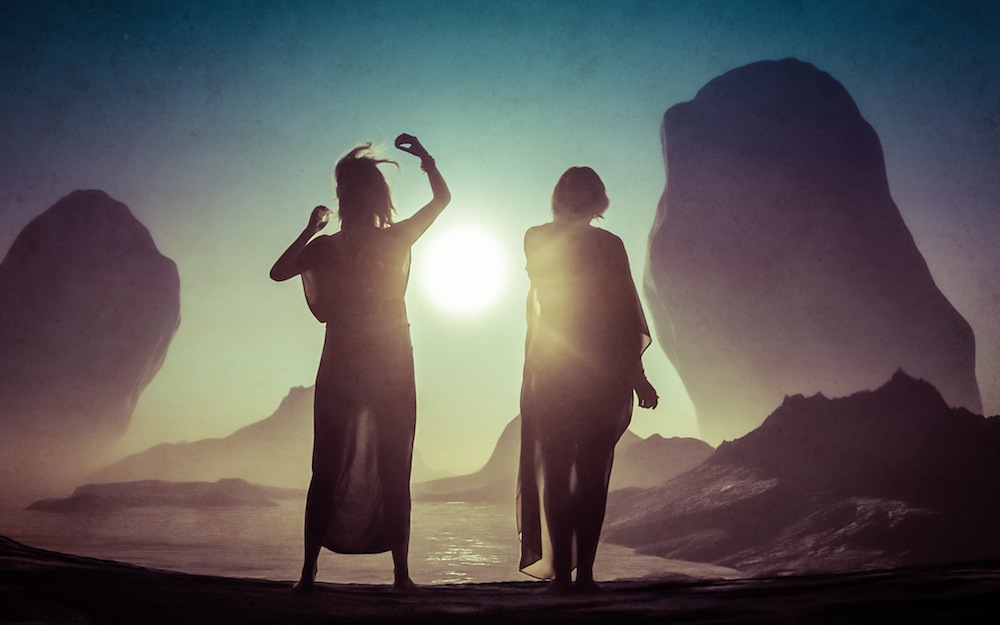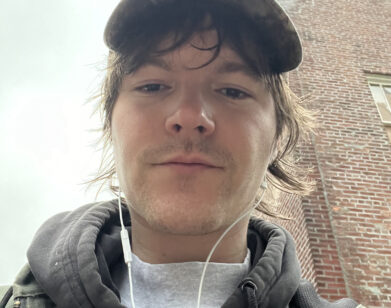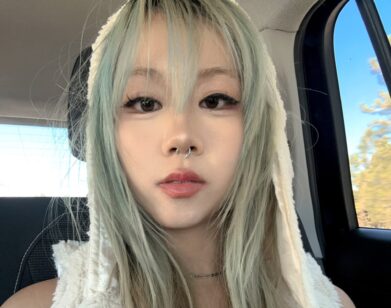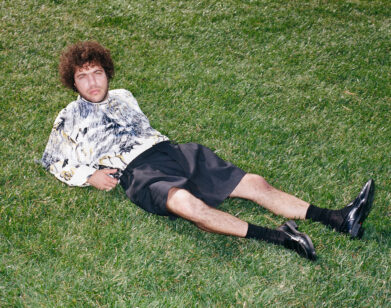Blond:ish, Off the Dance Floor

“We’re nomads,” Anastasia Corniere says about herself and musical partner Vivie-Ann Bakos when we speak. Known together as Blond:ish, Corniere and Bakos have just returned to Barcelona after two months of consistent traveling—both to play music and to make it. The two met in Montreal during 2007’s Winter Music Conference and moved to London three years later. Now based between Barcelona and Tulum, Mexico, Blond:ish first became known as club DJs. Soon, though, they began making their own music, and after 11 EPs, last year Blond:ish released Welcome to the Present, a debut full-length created entirely from live, albeit mysterious, recordings.
The journey within Welcome to the Present is almost as enigmatic as the setting in which it was created. The 11 songs—recorded in Mayan caves and a remote jungle—can be listened to individually, but the tracks are better understood when considered as a whole. For their live performance, Blond:ish have created an interactive experience, complete with digitally mapped 3-D projections that the two girls control. Although Bakos, who studied computer science at McGill University, understands the method, the two work with a close friend who translates their visual storyboards into code. “It has real time connectors so certain frequencies trigger certain visuals,” Bakos explains. “We’re always developing it because every time we watch it, we see something we want to add to make it better. You can add motion sensors—there are so many possibilities.”
Though they were happy to be home, it wasn’t for long. This weekend, Blond:ish will be performing during the first edition of SXMusic Festival on the island of Saint Martin in the Caribbean. From there, they will continue to Puerto Rico, Miami, Playa Del Carmen, Mexico, and more. We spoke with Corniere (who was born in France to a French father and Russian mother) and Bakos (born in Canada to Hungarian parents) via Skype to learn more about their history.
EMILY MCDERMOTT: Do you find that when you’re traveling you have more inspiration to create new music, opposed to when you are home?
VIVIE-ANN BAKOS: It depends. We’ve been in Tulum the past month, most of the time, and you get so inspired. Now that we’re back in Barcelona, we realize all of those inspirations and are putting them down on paper to make music with. It’s motivating.
ANASTASIA CORNIERE: Traveling is extremely inspiring. Meeting different people, all of the different cultures, live musicians even just walking down the street—let’s say you’re in India or South America, just hearing different musicians is incredibly inspiring.
One recent experience, we got a bunch of friends together in Tulum in January and everyone was a musician. We had a drummer, these two brothers who make their own instruments, a gong, singing bowls, and all sorts of percussion instruments, and we went inside a cenote, which is basically a cave. There’s thousands of them in the Yucatan, but we went to a secret one that not many people know and brought all of our instruments, played them, and recorded everything live. We’ve brought that back, so we’re using that recording to make music. Even the stalactites, they make really cool sounds. We were hitting them with different objects—not hard, we weren’t ruining nature, but the acoustics were incredible.
MCDERMOTT: How did you find the cave? Is it the same one you used for Welcome to the Present?
CORNIERE: No, we went to scout locations because we organized a sound meditation with this guy from New York and invited our friends, like 30 or 40 people. I needed to find a location, so I went to different cenotes, places all around Tulum, and we came across this one.
MCDERMOTT: So I know you two met in 2007 in Montreal but when did you each first become interested in music? Was it always part of your life growing up?
BAKOS: I think I became interested in music in a past life. It’s definitely not from this lifetime. It’s always been with me.
CORNIERE: For me, it definitely has a lot to do with my parents. My parents told me recently that one of my first words was “sique,” like in French “musique.” I would say “sique” when there would be music playing. Growing up there was always music playing, constantly.
BAKOS: My parents loved to party with their reel to reel. My dad would always make mixes and I got into music really early, just because music was always playing in the house. My dad made this switch so you can switch the speakers to any room in the house; I was always playing around with the reel to reel and the vinyl.
CORNIERE: We both also had early musical training. We had classical piano training but it was a lot of theory, which is boring when you’re young, so we both quit. Later we realized how important it would have been to keep going with these lessons, but at least a lot of it sticks with you.
MCDERMOTT: So when did you become interested in producing music?
BAKOS: I was producing before [we met] but nothing concrete. I think, really, when we moved to London five years ago, that was when everything switched and became official.
CORNIERE: We moved there because we were DJing in Montreal and getting a lot of bookings outside of Canada. We tried to make music but we never really got it together because we just had such a busy social life; every night of the week there would be something going on and we would be hungover. We lost focus. When we moved to London it was easier to settle down and concentrate in the studio because we didn’t have that many friends, and we wouldn’t always want to go out because it was cold and rainy. When we did go out, we went out for inspiration and got really inspired by the London music scene. But we really just locked ourselves in the studio for a long time, until we got some records out.
MCDERMOTT: Speaking of that, you had 11 EPs and finally released your first full-length last year. How did you know it was time to do an LP and what was the process like?
BAKOS: We wanted to say something different or tell some sort of story. We always loved [the thought of] a piece of music as a journey and we felt that we couldn’t do that with an EP. We were tinkering with the idea for a long time and it felt right last year. We had six weeks that we could do it, so we did.
CORNIERE: And Kompakt, the label that released it, had been asking us to do a concept album for a while. I think everyone was really surprised with what we came up with but it really captured the true essence of our experiences and travels through South America and Mexico. [We tried to] capture the vibe of Tulum as much as we could. We recorded almost everything live, so it had a different approach than our previous stuff, which was straight dance floor.
CORNIERE: I think they were expecting us to do a dance floor album, but we wanted to create something really different.
MCDERMOTT: I appreciate that you veered away from the straight dance floor. It creates such a more dynamic sound. Recently, I saw that you Tweeted a picture of birds and fish intertwined, claiming they are your spirit animals. Why are those your spirit animals?
BAKOS: [laughs] They’re not really spirit animals it’s more of an inside joke.
CORNIERE They are now our spirit animals. [laughs] In Mexico last year we were driving in a taxi and crossing a beachy area where it smells a lot like the sea, smells really strong like fish. We’re just laughing around and Viv’s like, “What’s that smell?” and I’m like, “Viv close your legs.” [laughs]
BAKOS: It would’ve been fine if it was just her and me and maybe our best friend, but there were strangers around.
CORNIERE: She was embarrassed!
BAKOS: No, I didn’t get embarrassed, it was just inappropriate. You can say anything you want, but at the time it was inappropriate. [laughs] Now it’s an inside joke, so anytime when [the group of people] hears, “what’s that smell,” it’s always, “Viv close your legs.” Always.
CORNIERE: Or anything that has to do with fish—after this we started talking about fish nonstop and we saw it everywhere. “What’s that drawing on the wall? Fish.” We would always send Viv pictures of fish. Recently our really good friend gave her a beautiful fish necklace that she got at an antique market years ago. So, that’s the fish part. Viv, you can tell the bird part.
BAKOS: I went to a pink lagoon, it’s actually pink, in Mexico. On the way, it’s like a three-hour drive, I’m talking to my friend in the car about bird watching, about how she went bird watching with her mom and how it was the most boring thing ever. I was quick to judge, I was like “Bird watching, that’s worse than going to jail. If I had to pick one I would pick going to jail.” I judged it so quickly, and the fact was, when we got to the pink lagoon, which is in a fisherman’s village, there were a ton of birds around because of the fish. So we sat there watching birds. We went into the biosphere and saw pink flamingos, saw all sorts of different birds, and ironically, all day I was bird watching. The lesson I took from that day is that what you don’t want is probably what you need in your life, and to be open to it.
MCDERMOTT: Do you have any recurring inspirations?
BAKOS: The present—that moment when you’re not thinking about anything and have no judgments. I find when I go to the jungle or to the mountains, away from the beach, I get really inspired there. There’s something about being deep in nature that always brings out a lot of creativity.
CORNIERE: That’s exactly what I would say. I find nature constantly inspiring. It’s all of these things you hear—animals are inspiring, trees… Really just being in nature.
FOR TICKETS TO SEE BLOND:ISH AT SXMUSIC FESTIVAL, VISIT THE FESTIVAL’S WEBSITE.






